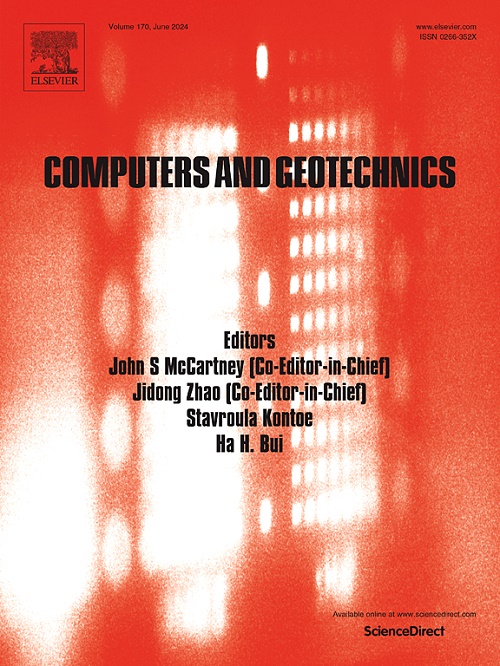浸没颗粒崩塌的动力学与流态:分形粒度分布的作用
IF 6.2
1区 工程技术
Q1 COMPUTER SCIENCE, INTERDISCIPLINARY APPLICATIONS
引用次数: 0
摘要
重力驱动的浸没颗粒流在自然过程和工业应用中都很普遍,对组成材料的粒度分布表现出显著的敏感性。本文采用计算流体力学-离散元耦合方法(CFD-DEM)系统研究了分形粒径分布(FPSD)多分散颗粒柱在变黏度流体中的崩塌过程。通过在不同的多分散体系中保持一致的初始体积分数,研究结果表明,FPSD对流动流动性的影响主要不是由局部孔隙压力演变的变化驱动的,而是由颗粒-流体相互作用的改变控制的。对流锋阻力与扩散速度关系的分析表明,流锋运动可以作为预测其流动流动性的可靠预测因子,特别是在低粘度情况下。此外,引入两个修正的无量纲参数(包含等效粒径)来重建流态图,从而阐明了FPSD在不同流体条件下的作用。最后,建立了多分散颗粒浸没崩落过程中流锋运动的理论模型。该模型成功地预测了多分散颗粒的归一化跳动距离与分形维数之间的相关性,同时也考虑了初始柱宽高比和颗粒密度的影响。这些发现为研究浸入式多分散颗粒材料在更复杂情况下的流动流动性提供了有价值的见解。本文章由计算机程序翻译,如有差异,请以英文原文为准。
Dynamics and flow regime of immersed granular collapse: role of fractal particle size distribution
Gravity-driven immersed granular flows are prevalent in both natural processes and industrial applications, exhibiting a significant sensitivity to particle size distribution of the constituent materials. This study employs a coupled computational fluid dynamics-discrete element method (CFD-DEM) approach to systematically investigate the collapse of polydisperse granular columns with fractal particle size distribution (FPSD) in fluids of varying viscosities. By maintaining a consistent initial volume fraction across different polydisperse systems, the findings indicate that the influence of FPSD on flow mobility is not primarily driven by changes in local pore pressure evolution but is instead governed by modifications in the particle–fluid interactions. An analysis of the relationship between the drag force at the flow front and spreading velocity reveals that the motion of flow front can serve as a reliable predictor for predicting its flow mobility, particularly in low-viscosity cases. Furthermore, two modified dimensionless parameters, incorporating an equivalent particle size, are introduced to reconstruct the flow regime diagram, which clarifies the role of FPSD under different fluid conditions. Finally, a theoretical model is developed to describe the motion of flow front during immersed polydisperse granular collapses. This model successfully predicts the correlation between normalized runout distance and fractal dimension of polydisperse particles, while also accounting for the effects of the initial column aspect ratio and particle density. These findings provide valuable insights into flow mobility of immersed polydisperse granular materials in more complex scenarios.
求助全文
通过发布文献求助,成功后即可免费获取论文全文。
去求助
来源期刊

Computers and Geotechnics
地学-地球科学综合
CiteScore
9.10
自引率
15.10%
发文量
438
审稿时长
45 days
期刊介绍:
The use of computers is firmly established in geotechnical engineering and continues to grow rapidly in both engineering practice and academe. The development of advanced numerical techniques and constitutive modeling, in conjunction with rapid developments in computer hardware, enables problems to be tackled that were unthinkable even a few years ago. Computers and Geotechnics provides an up-to-date reference for engineers and researchers engaged in computer aided analysis and research in geotechnical engineering. The journal is intended for an expeditious dissemination of advanced computer applications across a broad range of geotechnical topics. Contributions on advances in numerical algorithms, computer implementation of new constitutive models and probabilistic methods are especially encouraged.
 求助内容:
求助内容: 应助结果提醒方式:
应助结果提醒方式:


